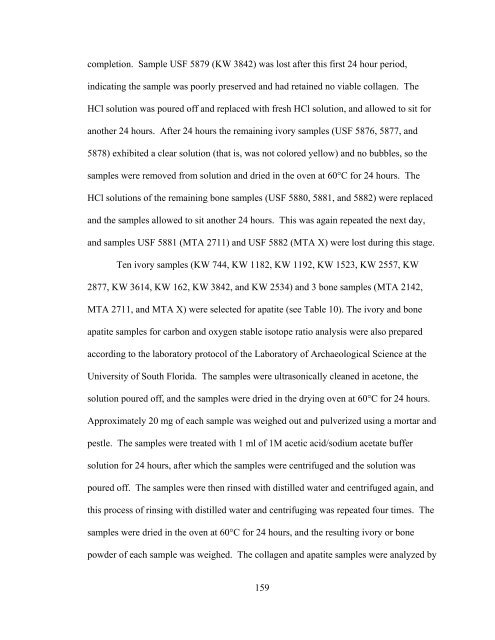Tracing the Source of the Elephant And Hippopotamus Ivory from ...
Tracing the Source of the Elephant And Hippopotamus Ivory from ...
Tracing the Source of the Elephant And Hippopotamus Ivory from ...
You also want an ePaper? Increase the reach of your titles
YUMPU automatically turns print PDFs into web optimized ePapers that Google loves.
completion. Sample USF 5879 (KW 3842) was lost after this first 24 hour period,<br />
indicating <strong>the</strong> sample was poorly preserved and had retained no viable collagen. The<br />
HCl solution was poured <strong>of</strong>f and replaced with fresh HCl solution, and allowed to sit for<br />
ano<strong>the</strong>r 24 hours. After 24 hours <strong>the</strong> remaining ivory samples (USF 5876, 5877, and<br />
5878) exhibited a clear solution (that is, was not colored yellow) and no bubbles, so <strong>the</strong><br />
samples were removed <strong>from</strong> solution and dried in <strong>the</strong> oven at 60°C for 24 hours. The<br />
HCl solutions <strong>of</strong> <strong>the</strong> remaining bone samples (USF 5880, 5881, and 5882) were replaced<br />
and <strong>the</strong> samples allowed to sit ano<strong>the</strong>r 24 hours. This was again repeated <strong>the</strong> next day,<br />
and samples USF 5881 (MTA 2711) and USF 5882 (MTA X) were lost during this stage.<br />
Ten ivory samples (KW 744, KW 1182, KW 1192, KW 1523, KW 2557, KW<br />
2877, KW 3614, KW 162, KW 3842, and KW 2534) and 3 bone samples (MTA 2142,<br />
MTA 2711, and MTA X) were selected for apatite (see Table 10). The ivory and bone<br />
apatite samples for carbon and oxygen stable isotope ratio analysis were also prepared<br />
according to <strong>the</strong> laboratory protocol <strong>of</strong> <strong>the</strong> Laboratory <strong>of</strong> Archaeological Science at <strong>the</strong><br />
University <strong>of</strong> South Florida. The samples were ultrasonically cleaned in acetone, <strong>the</strong><br />
solution poured <strong>of</strong>f, and <strong>the</strong> samples were dried in <strong>the</strong> drying oven at 60°C for 24 hours.<br />
Approximately 20 mg <strong>of</strong> each sample was weighed out and pulverized using a mortar and<br />
pestle. The samples were treated with 1 ml <strong>of</strong> 1M acetic acid/sodium acetate buffer<br />
solution for 24 hours, after which <strong>the</strong> samples were centrifuged and <strong>the</strong> solution was<br />
poured <strong>of</strong>f. The samples were <strong>the</strong>n rinsed with distilled water and centrifuged again, and<br />
this process <strong>of</strong> rinsing with distilled water and centrifuging was repeated four times. The<br />
samples were dried in <strong>the</strong> oven at 60°C for 24 hours, and <strong>the</strong> resulting ivory or bone<br />
powder <strong>of</strong> each sample was weighed. The collagen and apatite samples were analyzed by<br />
159

















